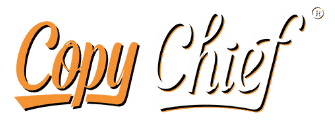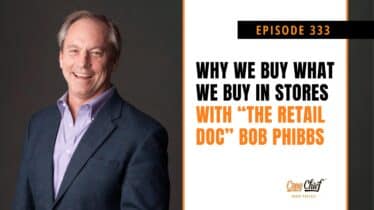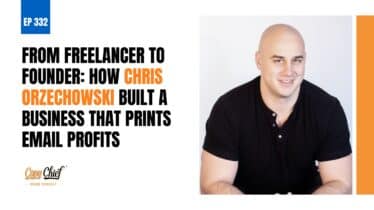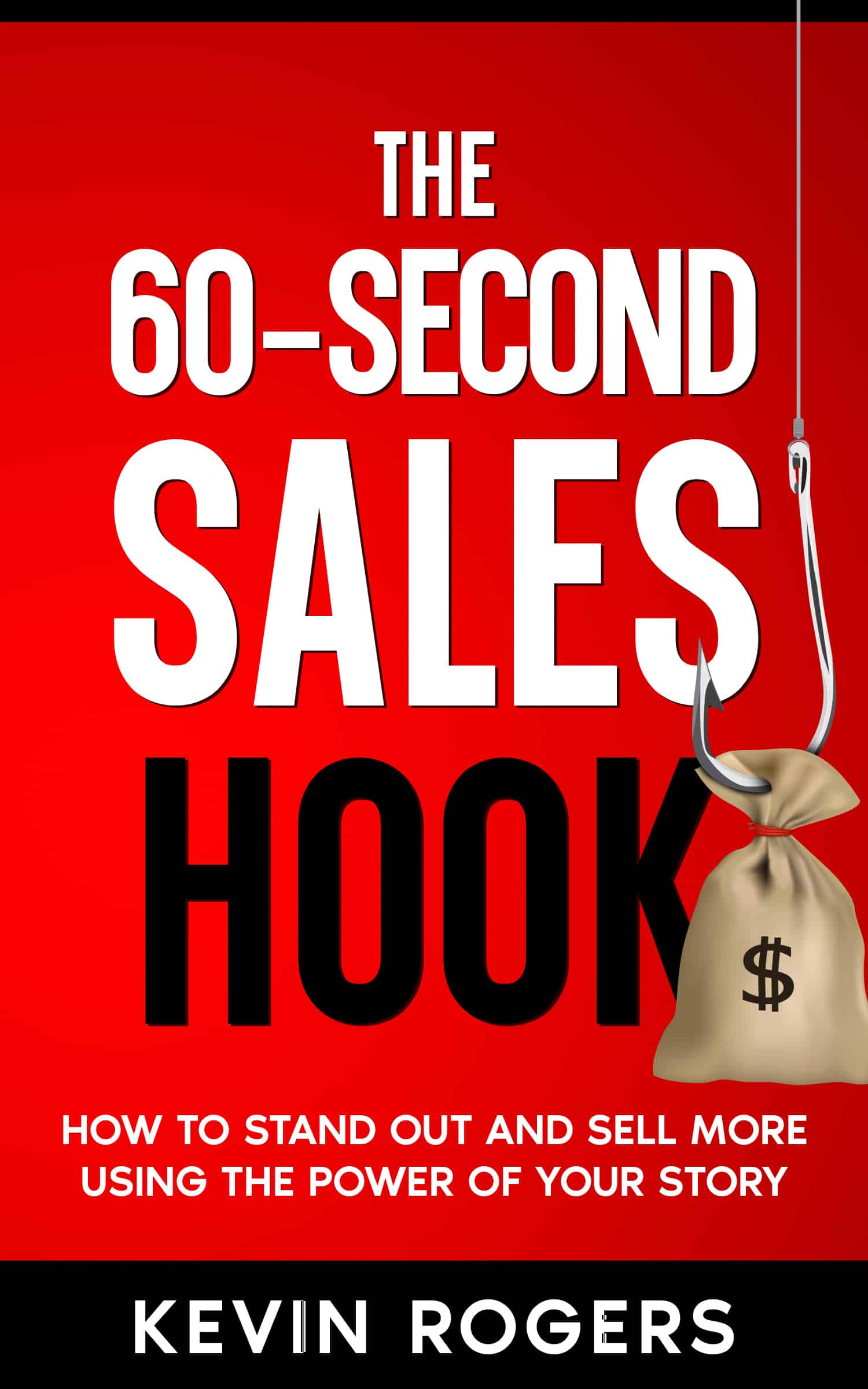My mouse was hovering over the buy button for Ramit Sethi’s Dream Job.
But I didn’t pull the trigger.
If you asked me why I would’ve said: “It’s too expensive.”
But the REAL reason was I didn’t think it could work for me.
I saw Ramit as this super motivated, driven guy. He spent his free time in college learning how to nail job interviews. By his mid-twenties, he was a bestselling author.
I spent college playing rugby in a suit with a cooler of margaritas on the sidelines. At 25, I was broke and clueless about what to do with my life (hence looking at Dream Job.)

Sure, Ramit hit on my pain points beautifully throughout the campaign. But I had this nagging belief his stuff wouldn’t work for me because:
“I’m just not wired like him.”
What I needed was proof his course would work for someone like me.
Give me a story of a clueless 25-year-old white dude barely scraping by who turned his life around by using this program.
Better yet, give me 3 of those stories. That would have proven beyond a shadow of a doubt that this could work for me.
When you ask your customers why they didn’t buy, they’ll probably say: “it’s too expensive” or “I don’t have time.”
98% of the time that’s B.S — and you know it.
The real reason?
They doubt themselves. They doubt their ability to get results. And they’re not sold your product is for them.
Sure, they see the testimonials. But they’re not able to see themselves in those people. Testimonials don’t connect deep enough with their current situation, fears, and doubts.
They prove authority and back up your claims. But they don’t show the journey that proves success is possible.
How to Get Your Reader To Believe
Your Product Will Work For Them!
But imagine you had an in-depth story for every avatar, “bucket,” or objection that came your way.
So if someone emails you saying: Your stuff is great, but I’m too busy.”
You send a gripping story of someone just like them (but even busier!) who had the same success they want.
You’re able to show undeniable proof your product will work specifically for them.
The good news: I bet you have those stories already!
But they may be buried in your inbox, on your Facebook community page, or on your website. (Or maybe they’re old and outdated.)
You’ve just gotta dig them up, polish them off, and make your case studies easier to digest than they are to ignore.
A few years after I didn’t buy Dream Job, I found myself working for Ramit as a copywriter. And re-doing some of his case studies.
Remembering what kept me from buying, I created case studies designed to connect with the unspoken doubts and struggles readers faces.
Each case study we made was designed to:
- Target a specific avatar and address a specific pain and objection
- Connect with the reader’s deeper fears and doubts using their language
- Let the reader interact with the story and consume it however they want (text, video, or skimming)
A big key was bringing the compelling parts of the story front and center.
So many businesses have amazing success stories. But they’re buried in long videos that nobody watches.
We gave the reader a high-level overview that let them immediately connect with the story.
Then layered hooks throughout case study to turn “skimmers” into readers.
Finally, we went deep into the emotional journey. We shared the key doubts and struggles the customer over came. And painted a picture of their new, better life. So readers could really see how success was not only possible — but how it would impact their lives.
The result is what I call Future Pacing Case Studies. Because they show how the reader can go all the way from where they are now to where they want to be.
I’ll show you how to do this below.
Follow the steps outlined here, and you can whip a killer case study in a couple of days.
I used this process writing success stories for Growthlab as well as my other clients:
How to Create Case Studies That Close Sales
Step 1: Mine for Gold
A great case study starts with finding a customer with a compelling story to tell.
Someone who:
- Had success with your product
- Faced the same hurdles as your audience (and is someone they can identify with)
- Is willing to open up, share their story, and sing your praises
You can check your inbox for success stories. Or send out a quick survey asking people what results they got and if they’re willing to talk about them.
Once you have someone on the phone, here are some great questions to ask:
- How did you find out about us?
- Have you tried a product like this before? What was your experience?
- What made you decide to buy?
- What was your biggest fear or reservation about buying?
- What surprised you most about this product?
- What was a major challenge you faced in getting the results you wanted? How’d you overcome it?
- What were the results? What’s important about that for you?
- Can you tell me a little moment you had that led you to say to yourself something like “I love my life” or “I can’t believe this is happening” that would not have been possible without [YOUR PRODUCT]?
This will give you a story full of emotion.
But remember, the real gold isn’t just in the questions. It’s in your FOLLOW UP to these questions.
For example, you may ask what doubt they faced before joining.
And they’ll say something like: “Oh I didn’t want to try something that didn’t work.”
Not bad. But let’s say you follow and say: “Tell me more about that.”
Then they tell you about the whiteboard filled with business ideas they have. And how they never pull the trigger out of fear.
Now we’re getting somewhere!
This is going from vague objections to a real story. Something the reader can connect with and believe.
By the way, a conversation like this happened in one of my interviews. We even included a picture of the whiteboard in the case study.

Step 2: Share the Highlight Reel
This lets you connect with where the reader is and where they want to be.
First, highlight who the person is in a way your customer can relate to.
It can be either their personal identity or the major struggle they have.
For example, people see themselves as a “busy single mom,” “corporate executive” or “artist who knows nothing about business.”
I like to call that out right on the Success Stories page. So people can click on the story that identifies with their situation.

Once people click on the page, you can give them the full story in a quick 3-6 sentences.
Here’s an example of how I did it with Ramit. First, we talk about how the subject (Danny) is a normal dude from Omaha who wanted a business but never got anywhere with it.
How many people can relate to that? Like, a billion?

In the next section, we show how this product helped him solve that problem.
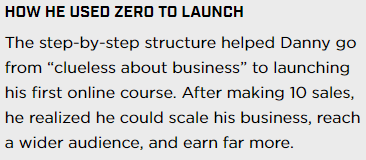
Then, we dive into the results.
When possible, I include both tangible and intangible outcome.
That way you touch on both the brain-based desire and the core emotion attached to it.
For example, here we talked about how getting a specific amount of money led to spending more time with his kids.
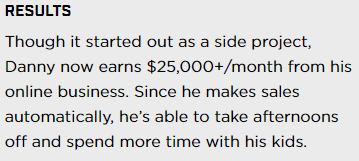
Also, notice the line that says: “though it started out as a side project.”
That’s a quick jab for all the people who think starting a business means they need to quit their job and do this full time. It proves they can do it on the side.
Step 3: Story Time!
After giving the highlights, it’s time to dive into the full story.
This gives the reader a chance to connect with the case study subject. Then see and feel what it would be like to be on this journey.
I use the same outline for my stories as the 60-second sales hook.
- Identity
- Struggle
- Discovery
- Result
The identity you can cover quick. And the sooner you can dive into the pain the better.
It’s like James Altucher says: “Bleed on the first line.” Show the pain early and often to grab attention, keep readers and engaged, and have them rooting for this person.
A great way to start is with a quote as a subhead. This helps you hit on the emotional pain WHILE entering the conversation going on in your reader’s mind.
An example:
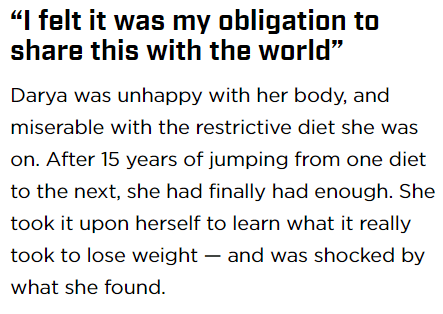
When telling the story, use your customers words as much as possible.
The words you write are to create context and frame the story. You want their quotes to make up most of the journey — the high points, struggle, results, and lessons learned.
Why?
Because it’s makes the copy pop. And it’s an easy way to connect with what your audience is thinking and feeling.
Here’s an example. This piece of text was used to describe a woman’s doubts and struggle:

See that? By using her quotes it’s easy to go deeper into that “fear of selling”. We get to show the specific guilt and fear behind it.
There’s a ton more we could talk about here.
Like how you want to stick with one core problem and one solution. And how to use a common enemy and introduce new obstacles to keep the story compelling.
Or how you can make your story pop and hit core emotions by showing the results your customers get (not just telling them.)
Like here, where we share a quote about a student’s life. Then include a fun lifestyle shot to paint the picture of what life can look like.
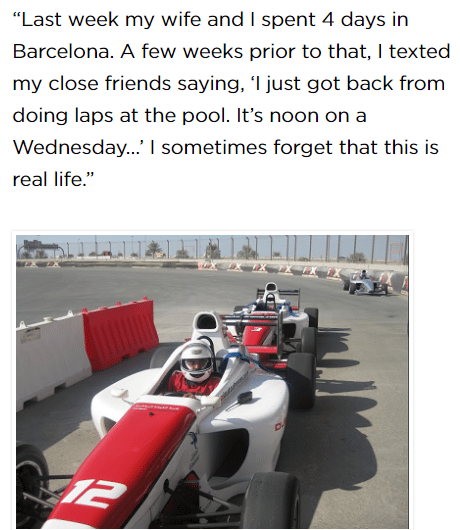
If you want more detail on how to turn your customers answers into a compelling story, check out part 4 of this free guide. I’d explain it here but this post is already long enough 🙂
Step 4: Keep it Compelling
Here are a few tips to keep your case studies real and engaging:
- Make it visual — ad graphics, charts, and pictures to back up what you’re saying in the text. This makes the story feel real and engaging.
- Teach! Don’t just tell a story, give something valuable your reader can use immediately. I learned this when I was writing for Jon Morrow. Make your case studies educational and valuable and people share them with friends and communities.
- Tell the story with subheads. This helps skimmers get the gist and can pull people into the story.
- Include video and text. Some people prefer to read; others watch a video. Have both modalities and you capture different types of consumers.
How to Turn Case Studies into Sales
Once you have your case studies, here are some good ways to use them.
You can release them before your product launch. Send out a couple of stories to create a desire for what’s about to come.
For example, Ryan Levesque emailed 3 case study videos before a super successful Ask launch.
The case studies revolved around specific challenges the audience faces.
It wasn’t “look at this amazing result my client got.” It was “look at how this person overcame setbacks” and “see how this person found their “WHY.”
He teaches these life lessons through a case study of someone having success with his course.
Pretty smart.
Speaking of Ryan Levesque, if your using ASK you can share “bucket-specific” case studies throughout your launch. (If you’re not familiar with “buckets”, it basically means case studies specific to each avatar.)
To start, you can tweak your product launch content videos. Instead of creating one set of videos for everyone, you can add case studies specific to each “bucket” or avatar. Then segment your list, so people are only getting videos with stories specific to them.
Also, during sales week, you can email success stories specific to each segment of your list.
If you don’t have a segmented list, you can call out the different avatars and struggles in an email, with a link to a full story that relates to that type of person.
Finally, you can do a full case-study launch like Project Rockstar. They sent out 8 emails — all case studies — then opened the doors to their 5-figure course. And got a flood of applications.
You can also use them as a lead magnet. Like the guys at Trafficandfunnels.com did.

Get Your Killer Case Study Today!
Remember that list of questions from step 1?
You can send them (or a select handful of them) in a survey to your audience today.
At the bottom of the survey, ask for their name/email and if they’re willing to do a full case study interview. (In your email, remind them their story can inspire thousands. That will give them a reason to answer these questions.)
What’s cool here is:
- You’ll get a ton of testimonials
- You can put those questions and your customer’s answers on your site directly. This is a great “placeholder” until you do the interview and get the full story. (One of my clients Navid Moazzez does a great job of this.)
- You’ll know some of your top customers for case studies.
Then you can go deeper into their journey. And uncover a compelling story that will target a section of your audience.
Eventually, you’ll have a case study for every circumstance and objection your audience can possibly think of.
If you want to go deeper into how to dig up inspiring stories and turn them into sales-closing case studies, you can download the free Ultimate Guide to Case Studies here.
Resources:
- Naveen’s sucess story – https://growthlab.com/success-stories/naveen/
- Danny’s success story – https://growthlab.com/success-stories/danny/
- Darya’s success story – https://growthlab.com/success-stories/darya/
- Caitlin’s success story – https://growthlab.com/success-stories/caitlin/
